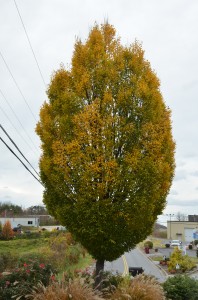Upright European hornbeams (Carpinus betulus cvs.) are versatile small to medium-sized deciduous trees that fit most landscape settings. Depending on which cultivar you select, the tree stands with a narrow vertical profile. It grows 35-40 feet tall and 15-20 feet wide. It’s cookie cutter by design as a street tree or tall narrow hedge.
Hornbeams are best planted in late winter balled and burlapped (B&B) and in any month if container-grown. Tall popular cultivars ‘Fastigiata’ and ‘Columnaris’ are being supplanted by shorter growing ‘Frans Fontaine’.
Leaves are small, dark glossy green on the surface and finely serrated along the edge. Autumn foliage turns golden yellow. Tiny spring flowers and pendulous clusters of samara seeds are ornamentally insignificant. European hornbeam is often nicknamed “muscle wood” or “ironwood” as its smooth gray main trunk is muscular.
Annual growth rate is slow. Hornbeams are long-lived when properly sited and nurtured. They prefer in moist, well-drained, acidic to slightly alkaline pH soil. Full open sunlight or partial 5 to 6 hours of sunlight is adequate. Newly planted trees should be irrigated every 7 to 10 days over the first two summers if summers are unusually dry. Otherwise, hornbeams are moderately drought tolerance. Fertilize young trees in late winter with granular 10-10-10 or equivalent. Pruning is rarely needed except to maintain the narrow upright form.
Young trees may be fashioned into a tall hedge or screen, set out 5 to 10 feet apart. Create a garden arch by planting two rows 8-10 feet apart; bend and attach tree tops (leaders) over time to form a natural archway or hut.


 Posted in
Posted in 
